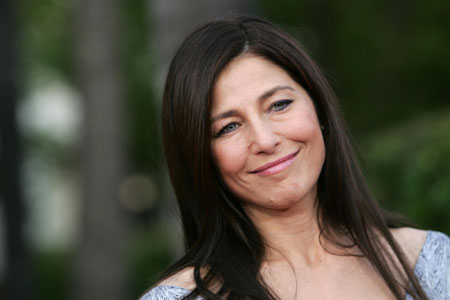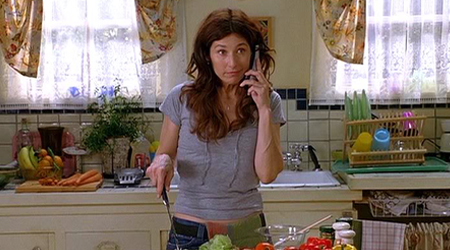Craig from Dark Eye Socket here with this week's Take Three. Today: Catherine Keener

Take One: Being John Malkovich (1999)
Do you think it’s possible to admire an actress’ immense talent yet still be somewhat immune to her overall allure or effectiveness? Or perhaps it’s fair to acknowledge their greatness, but have issues with many of their performances? It’s been this way with me and Cathy K for eleven years. It was very likely Being John Malkovich that kick-started my general viewer/star incompatibility with Keener. I did, however, enjoy her sarcastically dry, bolshy, personality-destroying task master Maxine Lund in Spike Jonze’s breakthrough film a great deal. But in the film – and in many things since – she’s baffled, transfixed, annoyed and intrigued me in equal measure. Watching one of her films is a tug-of-war filled with both appreciation and irritation.

Objectively I can see just how good a performance Keener gives here (something evident to anyone watching). She has her eye on the ball at all times. Maxine’s never less than alert to her surroundings and ready to manipulate any sad interlopers who infiltrate them to her advantage. While sympathetic to protagonist John Cusack’s plight, I didn’t blame Maxine for maneuvering every event to her betterment. Malkovich was the key film in how I came to view Keener as an oddly awkward yet undeniably captivating screen presence. Maybe her interpretation of this adversely egoistical role was too successful and the character and actress detrimentally intertwined in my mind.
Keener herself apparently didn’t originally think she was right for the part because of her dislike of Maxine. Regardless, her Best Supporting Actress Oscar nod was well deserved. Unlike her second one...
Take Two: The 40-Year-Old-Virgin (2005)
...or should I say her second Oscar nomination was misplaced?
Her performance in 2005’s Capote (a dry, awards-baiting affair, in my humble opinion) secured her a second supporting Oscar nomination, but in my estimation she was underused and underwhelming. But she shone brightly as Trish Piedmont in The 40-Year-Old Virgin that same year. If only Oscar embraced the funny more readily, and more frequently, vivacious roles like this one might get due recognition. She was full of energy, spirit and, significantly, character: Trish was a grandmother before her time, with a messy love life, and making a living selling second-hand eBay goods.

Keener worked her odd magic. She managed to easefully instill Trish with both maternal drive and sensual vibrancy. Her romantic scenes with Steve Carell made for some of the most refreshingly amiable, out-of-the-blue moments in a rom-com in years. Instead of the usual youth-orientated teen-love tribulations, here was a grown-up love story with infinite good will and a smattering of kind-heartedness. I’d say that Keener worked harder in creating a fully-fleshed-out performance from an original script here than she did with the real (and therefore easily-researchable, yet ultimately rather two-dimensional) figure of Harper Lee. We can’t go back in time and alter the Oscar voters’ minds, but we can recalibrate our viewing habits and put our hearts and funny-bones first to celebrate Trish more.
Take Three: Please Give (2010)
To my eyes and ears at least, Please Give is Keener’s most fully-rounded, intricate and emotionally spot-on performance to date. It’s a close-to-perfect piece of acting. There’s an built in disparity, an imbalance, within Keener’s trendy-antiques dealer Kate: she repossess the recently-deceased’s wares and sells them on at a higher mark-up (like Virgin, Keener’s again selling other people’s stuff), yet she also doles out any spare change she has to New York’s homeless without a second thought. The journey Kate takes over the course of Nicole Holofcener’s film is, of course, all about the act and exploration of giving. But Keener’s acting is never simplistic or easily-fathomable. Her work is bold yet accessible, and full of directional pulls and emotional bumps which resonate beyond the film’s duration; it makes us question our own charitable ideologies. Misplaced empathy and foolhardy ingratiation are tricky emotional states to pin down, but Keener nails both.

Two moments illustrate this best. In one memorable scene she visits a group of learning-needs children to volunteer help, but immediately breaks down in tears of knee-jerk empathy, and is told to leave by the manager. She plays this with a matter-of-fact kindness which is plainly transferable, recognisable to anyone who’s ever attempted to give something but has never been exactly sure why. In another moment, when she's deeply contemplating her lot in life and her atttitude of 'give and take', she glances over at a newly-acquired antique chair and envisions the dead owner sitting in it. This series of simple actions, beautifully directed by Holofcener and seamlessly carried out by Keener, tell us everything about Kate’s emotional state at that crucial point in the film, without fuss or words. It’s a well considered and perfectly executed example of how acting can directly translate unspoken emotion with quiet power. After eleven years of curious uncertainty, under a minute of screen time aroused a new level of Keener keenness within me.
Three more films for the taking: Living In Oblivion (1995), Death to Smoochy (2002), Into the Wild (2007)